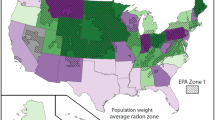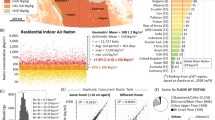Abstract
Exposure to radon gas increases the risk of lung cancer. Preliminary national survey data collected by Health Canada indicate that approximately 10% of households exceed the recommended federal long-term guideline of 200 Bq/m3. However, results to date have been reported for large geographic areas in broad measurement categories. Given that Health Canada recommends the most rapid remediation for buildings with the highest concentrations, such reporting makes it challenging for public health authorities to target interventions to communities at the highest risk. Here we use data from a survey in British Columbia to illustrate how improved spatial resolution and more refined concentration categories would be valuable for prioritizing the use of limited public health resources. We encourage Health Canada in future to provide more specific, community-level information that can be used to inform local policy and to engage building owners in radon testing and remediation.
Résumé
L’exposition au radon accroît le risque de cancer du poumon. Selon les données préliminaires d’une enquête nationale de Santé Canada, environ 10 % des ménages dépassent les lignes directrices fédérales recommandées à long terme pour le radon, qui sont de 200 Bq/m3. Cependant, les données recueillies jusqu’à maintenant concernent de vastes zones géographiques et de grandes catégories de mesure. Comme Santé Canada recommande que l’on assainisse le plus rapidement possible les bâtiments qui présentent les plus fortes concentrations de radon, des données aussi générales n’aident pas les autorités de santé publique à concentrer leurs interventions sur les communautés les plus à risque. Nous utilisons ici les données d’une enquête menée en Colombie-Britannique pour montrer que la résolution spatiale améliorée et des catégories plus étroitement définies seraient utiles pour prioriser l’utilisation des ressources de santé publique limitées. Nous encourageons Santé Canada à fournir à l’avenir des données plus précises, recueillies à l’échelle communautaire; ces données pourraient étayer les politiques locales et inciter les propriétaires de bâtiments à effectuer des tests de radon et à prendre des mesures d’assainissement.
Similar content being viewed by others
References
Health Canada. Guide for Radon Measurements in Residential Dwelllings (Homes). Ottawa, ON: Health Canada, 2008;15.
Agency for Toxic Substances and Disease Registry. Draft Toxicological Profile for Radon. Atlanta, GA: US Department of Health and Human Services, 2008;230.
Samet JM. Radon and lung cancer. J National Cancer Institute 1989;81(10):745–58.
Al-Zoughool M, Krewski D. Health effects of radon: A review of the literature. Int J Radiation Biol 2009;85(1):57–69.
National Research Council Committee on Health Risks of Exposure to Radon (BEIR VI). Health Effects of Exposure to Radon. Committee on the Biological Effects of Ionizing Radiations, Board of Radiation Effects Research, Committee on Life Sciences, National Research Council. Washington, DC: National Academy Press, 1999.
Darby S, Hill D, Deo H, Auvinen A, Barros-Dios J, Baysson H, et al. Residential radon and lung cancer—detailed results of a collaborative analysis of individual data on 7148 persons with lung cancer and 14,208 persons without lung cancer from 13 epidemiologic studies in Europe. Scand J Work Environ Health 2006;32(S1):1–83.
Health Canada. Government of Canada Radon Guideline. 2009. Available at: https://doi.org/www.hc-sc.gc.ca/ewh-semt/radiation/radon/guidelines_lignes_direc-trice-eng.php (Accessed August 10, 2011).
Health Canada. Cross-Canada Survey of Radon Concentrations in Homes: Year 1 Interim Report. Ottawa: Health Canada, 2010;12.
Miles J. Temporal variation of radon levels in houses and implications for radon measurement strategies. Radiation Protection Dosimetry 2001;93(4):369–75.
World Health Organization. WHO Handbook on Indoor Radon: A Public Health Perspective. Geneva, Switzerland: WHO, 2009;94.
Spiegel JM, Krewski D. Using willingness to pay to evaluate the implementation of Canada’s residential radon exposure guideline. Can J Public Health 2002;93(3):223–28.
Author information
Authors and Affiliations
Corresponding author
Additional information
Acknowledgements: The data used to illustrate this commentary were collected by David Morley (BCCDC) and Chris Van Netten (UBC). We feel fortunate to have this rich dataset available to address questions related to residential radon in British Columbia.
Conflict of Interest: None to declare.
Rights and permissions
About this article
Cite this article
Henderson, S.B., Kosatsky, T. & Barn, P. How to Ensure That National Radon Survey Results Are Useful for Public Health Practice. Can J Public Health 103, 231–234 (2012). https://doi.org/10.1007/BF03403819
Received:
Accepted:
Published:
Issue Date:
DOI: https://doi.org/10.1007/BF03403819




